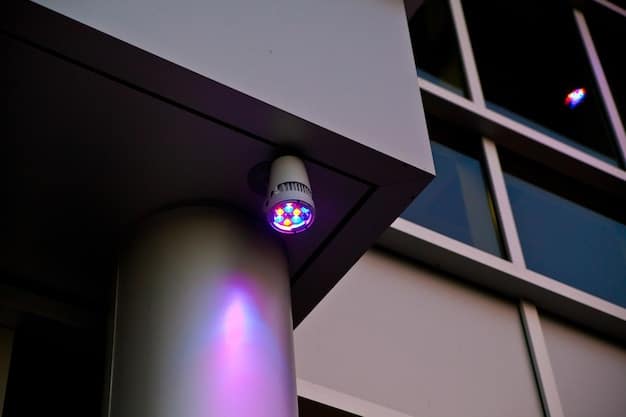Smart Security Cameras: Protecting Your Privacy in 2025

Smart Security Cameras: How to Avoid Privacy Risks and Protect Your Data in 2025 focuses on practical strategies, addressing concerns like data breaches and unauthorized access to ensure your home security doesn’t compromise your personal information.
Smart Security Cameras: How to Avoid Privacy Risks and Protect Your Data in 2025 is a pressing concern for homeowners embracing smart home technology. As these cameras become increasingly prevalent, understanding how to safeguard your personal data from potential vulnerabilities is essential. Are you ready to learn how to keep your home secure without compromising your privacy?
Understanding the Landscape of Smart Security Cameras in 2025
Smart security cameras have evolved significantly, offering features like facial recognition and cloud storage. But with increased functionality comes increased complexity in managing your data and privacy. Understanding the current landscape is the first step in protecting yourself.
Let’s delve into the key features and evolving market trends shaping smart security cameras, setting the stage for navigating privacy risks effectively.
Key Features of Modern Smart Security Cameras
Modern smart security cameras boast a range of features designed to enhance home security. Understanding these features and their potential implications is crucial for making informed decisions about your system.
- Facial Recognition: Identifies individuals, but raises concerns about data storage and potential misuse.
- Cloud Storage: Convenient for accessing footage remotely, but reliant on the provider’s security measures.
- Two-Way Audio: Allows communication through the camera, which can be a security risk if compromised.
- Motion Detection: Triggers recording based on movement, minimizing storage needs but potentially capturing sensitive moments.
Knowing what your smart security camera is capable of is paramount for adapting your usage to a secure setup.
The smart security camera market is expected to continue its growth trajectory, with projections indicating a substantial increase in adoption over the coming years. This growth is primarily driven by increasing awareness concerning home security and the convenience afforded by these systems. Technological innovations such as enhanced AI capabilities, improved video resolution, and seamless integration with other smart home devices are additional catalysts fueling market expansion.
In conclusion to this introductiory part, by staying informed about camera features and market growth, you’re positioning yourself to protect your privacy amidst the evolving landscape of smart home technology.
Identifying Potential Privacy Risks with Smart Security Cameras
Smart security cameras are convenient, but they also come with potential privacy risks. It’s important to be aware of these risks so you can take steps to protect yourself. Recognizing the vulnerabilities associated with smart security cameras is paramount to mitigating potential privacy breaches. From hacking to data leaks, there are several factors to consider.
Let’s explore the common security vulnerabilities that could compromise your privacy when using these devices.

Common Security Vulnerabilities
Understanding the technical vulnerabilities that exist is essential for creating a secure smart home environment. Here are some typical issues:
- Weak Passwords: Easy-to-guess credentials are a primary entry point for hackers.
- Unsecured Networks: Using public Wi-Fi can expose your camera to unauthorized access.
- Outdated Firmware: Failing to update your camera’s software can leave it vulnerable to known exploits.
Always make a habit to keep your passwords safe and secure with the aim to minimize potential privacy risks.
Beyond technical vulnerabilities, there are also risks associated with how your data is stored and managed. Many smart security cameras rely on cloud storage, which means your footage is stored on servers owned by the camera manufacturer or a third-party provider. This arrangement introduces the possibility of data breaches or unauthorized access by employees or hackers.
Additionally, some camera manufacturers may collect and share user data with advertisers or other third parties. This data can include personally identifiable information, such as your name, address, and viewing habits. Before purchasing a camera, carefully review the manufacturer’s privacy policy to understand how your data will be used and whether you have the option to opt out of data collection.
Wrapping up, recognizing these privacy risks associated with smart security cameras is crucial for taking proactive steps to safeguard your personal information and protect your home from potential security breaches.
Implementing Strong Security Measures for Your Smart Cameras
Mitigating privacy risks requires proactive steps. By implementing robust security measures, you can significantly reduce the chances of your smart camera being compromised. Securing your smart security cameras involves a multi-layered approach, encompassing strong passwords, secure networks, and timely firmware updates.
Let’s look at the essential strategies you can implement to enhance the security of your smart home setup.
Essential Security Practices
Here are some security practices you should know and apply:
- Strong Passwords: Ensure you create unique, complex passwords for each device and account.
- Secure Network: Use a strong, encrypted Wi-Fi network and consider a separate network for IoT devices.
- Regular Updates: Keep your camera’s firmware updated to patch security vulnerabilities.
Applying secure practices and security know-how decreases significantly potential risks associated with cameras breaches.
Enabling two-factor authentication (2FA) adds an extra layer of protection by requiring a secondary verification method, such as a code sent to your smartphone, to access your account. This makes it much harder for hackers to gain unauthorized access, even if they manage to obtain your password. Many smart security camera systems offer two-factor authentication as an option, and it’s highly recommended to enable it.
Additionally, consider investing in a virtual private network (VPN) for your home network. A VPN encrypts all traffic coming and going from your network, making it harder for hackers to intercept your data. This can be especially useful if you frequently access your camera’s footage remotely, as it protects your data from being intercepted on public Wi-Fi networks.
In summarization, by adopting essential security practices and staying proactive in monitoring your smart security camera system, you can significantly reduce the risk of unauthorized access and protect your privacy in the digital world.
Reviewing Privacy Settings and Data Management Options
Once you’ve secured your camera and network, it’s important to review the privacy settings offered by your device and the service provider. Understanding what data is collected and how it’s used is crucial for maintaining control over your personal information. Every platform offers particular configurations so that the user is able to define camera setups.
We will explore how to navigate these settings to minimize data collection and protect your privacy.

Optimizing Your Privacy Settings
Take control of your data and privacy with these settings:
- Data Encryption: Enable encryption to protect your data during storage and transmission.
- Motion Detection Zones: Define specific areas for motion detection to reduce unnecessary recordings.
- Recording Schedules: Set specific times for recording to minimize capturing sensitive activities.
- Privacy Zones: Black out areas in the camera’s view that you don’t want to be recorded, such as a neighbor’s window.
These setups offer a complete privacy setup for each security camera that you configure on the platform of your choosing.
It’s equally important to understand data retention policies. Most camera manufacturers and service providers have policies in place that govern how long your footage is stored and what happens to it after that period. Find out how long your footage is stored and whether you have the option to delete it manually. If you’re concerned about privacy, consider opting for a shorter retention period or deleting footage more frequently.
Also, be wary of data sharing practices. Some camera manufacturers may share user data with advertisers or other third parties for marketing purposes. Review the privacy policy carefully to understand whether your data is being shared and whether you have the option to opt out. If you’re not comfortable with the data sharing practices, consider choosing a camera from a manufacturer that prioritizes privacy.
Wrapping up this topic, by actively reviewing your privacy settings, you can minimize data collection and protect your personal information from falling into the wrong hands.
Staying Informed About Data Protection Laws and Regulations
Data protection laws are constantly evolving, especially those related to AI. Understanding these laws can help you navigate the complex landscape of smart home security and privacy. Navigating the complexities of data protection laws requires staying informed about updates and regulations that impact smart security camera usage.
We’ll discuss how to stay informed and what to look for in upcoming legislation.
Key Data Protection Laws to Know
Here are some key factors to consider:
- GDPR (Europe): Focuses on consent, data minimization, and the right to be forgotten.
- CCPA (California): Grants consumers the right to know what data is collected and to opt out of its sale.
- Future AI Regulations: Anticipate stricter rules on data collection, algorithmic transparency, and usage restrictions in security systems.
Staying up to date on this information is essential for keeping your personal information safe.
Data protection laws are constantly evolving, so it’s essential to stay informed about the latest developments. Subscribe to industry newsletters, follow privacy experts on social media, and regularly check the websites of data protection authorities for updates. By staying informed, you can ensure that you’re aware of your rights and obligations under the law.
Furthermore, consider joining privacy advocacy groups. These groups work to promote data protection and advocate for stronger privacy laws. By joining, you can stay informed about upcoming legislation and participate in efforts to shape the future of data protection.
In conclusion for this section, by staying informed about data protection laws and regulations, you can better understand your rights and obligations, and take proactive steps to protect your privacy in the age of smart security cameras.
Future-Proofing Your Smart Home Security
The smart home landscape is constantly evolving. To maintain your privacy in the long term, you need to future-proof your security measures. As technology advances, so do the threats to your privacy. Future-proofing your approach to smart security camera privacy requires a proactive mindset and a commitment to continuous learning.
Let’s discuss strategies to ensure your privacy remains intact as technology advances.
Strategies for Long-Term Security
By applying these strategies, you can guarantee a long-term security:
- Regular Audits: Periodically review your camera’s settings and data usage.
- Technology Upgrades: Replace older cameras with newer models that offer enhanced security features.
- Vendor Scrutiny: Research the security practices of camera manufacturers before purchasing.
Future-proofing also relies on consistent research with the aim to update your knowledge regarding privacy topics to prevent unfortunate events.
Beyond adopting advanced technologies, fostering a culture of privacy awareness within your household is equally important. Educate family members and guests about the potential privacy risks associated with smart security cameras and encourage them to adopt privacy-friendly habits. This may involve setting ground rules for camera usage, such as avoiding sensitive conversations in camera view, or implementing strict access controls to prevent unauthorized access to footage.
Additionally, consider investing in privacy-enhancing technologies that can further bolster your defenses. These technologies may include VPNs, ad blockers, and privacy-focused browsers that help to shield your online activity from prying eyes. By integrating these technologies into your smart home ecosystem, you can create a more secure and privacy-conscious environment.
In summary, by future-proofing your smart home security with proactive measures, you can navigate the evolving landscape of technology and protect your privacy against emerging threats.
| Key Point | Brief Description |
|---|---|
| 🔒 Strong Passwords | Use unique, complex passwords for all devices & accounts. |
| 🌐 Secure Network | Encrypt your Wi-Fi & consider a separate network for IoT devices. |
| 🔄 Regular Updates | Keep camera firmware updated for security patches. |
| 🛡️ Privacy Settings | Optimize data encryption, motion zones & recording schedules. |
Frequently Asked Questions (FAQ)
▼
While not all smart security cameras are easily hacked, those with weak security measures or outdated firmware are more vulnerable. Implementing strong passwords and keeping software up to date can significantly reduce this risk.
▼
Unusual camera movements, strange noises, or unfamiliar access requests can indicate a compromised camera. Regularly check your camera’s activity logs and enable notifications for unusual activity.
▼
Privacy zones allow you to block out specific areas in the camera’s view, such as a neighbor’s window or a public street. This ensures that you’re not recording areas where people have a reasonable expectation of privacy.
▼
Cloud storage can be convenient, but it’s crucial to choose a provider with robust security measures. Look for encryption, two-factor authentication, and transparent data policies to ensure your footage is protected.
▼
Before disposing of old smart cameras, perform a factory reset to wipe any personal data. Additionally, physically destroy the camera to prevent it from being reused without your knowledge.
Conclusion
Protecting your data when using smart security cameras: How to Avoid Privacy Risks and Protect Your Data in 2025 requires a proactive approach. By understanding the risks, implementing strong security measures, and staying informed about data protection laws, you can enjoy the benefits of smart home security without compromising your privacy.





